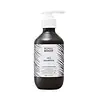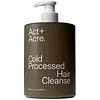What's inside
What's inside
 Key Ingredients
Key Ingredients

 Benefits
Benefits

 Concerns
Concerns

 Ingredients Side-by-side
Ingredients Side-by-side

Aloe Barbadensis Leaf Juice
Skin ConditioningSodium Methyl Cocoyl Taurate
CleansingCocamidopropyl Betaine
CleansingDecyl Glucoside
CleansingCoco-Glucoside
CleansingGlyceryl Oleate
EmollientPropanediol
SolventHydrolyzed Quinoa
Skin ConditioningPolyquaternium-10
Potassium Sorbate
PreservativeOlea Europaea Fruit Oil
MaskingMentha Piperita Oil
MaskingHippophae Rhamnoides Fruit Oil
Skin ProtectingMentha Arvensis Callus Lysate
AntioxidantHydrolyzed Jojoba Esters
Skin ConditioningLinum Usitatissimum Seed Oil
PerfumingSqualane
EmollientHelianthus Annuus Seed Oil
EmollientMacadamia Ternifolia Seed Oil
EmollientRosmarinus Officinalis Leaf Extract
AntimicrobialSerenoa Serrulata Fruit Extract
Skin ConditioningHibiscus Sabdariffa Flower Extract
Skin ConditioningHylocereus Undatus Fruit Extract
Skin ConditioningUrtica Dioica Leaf Extract
Skin ConditioningEquisetum Arvense Leaf Extract
AstringentChamomilla Recutita Flower Extract
MaskingPentylene Glycol
Skin ConditioningCaprylyl Glycol
EmollientEthylhexylglycerin
Skin ConditioningCitric Acid
BufferingAloe Barbadensis Leaf Juice, Sodium Methyl Cocoyl Taurate, Cocamidopropyl Betaine, Decyl Glucoside, Coco-Glucoside, Glyceryl Oleate, Propanediol, Hydrolyzed Quinoa, Polyquaternium-10, Potassium Sorbate, Olea Europaea Fruit Oil, Mentha Piperita Oil, Hippophae Rhamnoides Fruit Oil, Mentha Arvensis Callus Lysate, Hydrolyzed Jojoba Esters, Linum Usitatissimum Seed Oil, Squalane, Helianthus Annuus Seed Oil, Macadamia Ternifolia Seed Oil, Rosmarinus Officinalis Leaf Extract, Serenoa Serrulata Fruit Extract, Hibiscus Sabdariffa Flower Extract, Hylocereus Undatus Fruit Extract, Urtica Dioica Leaf Extract, Equisetum Arvense Leaf Extract, Chamomilla Recutita Flower Extract, Pentylene Glycol, Caprylyl Glycol, Ethylhexylglycerin, Citric Acid
Water
Skin ConditioningSodium Lauroyl Methyl Isethionate
CleansingSodium Cocoyl Apple Amino Acids
Skin ConditioningTriethyl Citrate
MaskingSorbitan Oleate Decylglucoside Crosspolymer
CleansingHydroxypropyl Starch Phosphate
Lauramidopropyl Betaine
CleansingGlycerin
HumectantAcrylates Copolymer
Acrylates/Beheneth-25 Methacrylate Copolymer
Adansonia Digitata Seed Oil
EmollientAmaranthus Caudatus Seed Oil
EmollientAmyris Balsamifera Bark Oil
MaskingAquilaria Agallocha Wood Oil
MaskingCananga Odorata Flower Oil
MaskingCaprylyl Glycol
EmollientCistus Ladaniferus Leaf/Stem Extract
MaskingCitric Acid
BufferingCocamide Mipa
EmulsifyingDimethylheptenal
PerfumingElettaria Cardamomum Seed Oil
MaskingGamma-Nonalactone
MaskingGlycol Distearate
EmollientHelianthus Annuus Seed Oil
EmollientHexenyl Acetate
MaskingHexylene Glycol
EmulsifyingIonone
AstringentJuniperus Virginiana Oil
MaskingLavandula Angustifolia Oil
MaskingMenthyl Ethylamido Oxalate
Skin ConditioningMoringa Oleifera Seed Oil
EmollientPanthenol
Skin ConditioningPhenoxyethanol
PreservativePogostemon Cablin Leaf Oil
MaskingPotassium Sorbate
PreservativeRosmarinus Officinalis Leaf Extract
AntimicrobialSodium Hydroxide
BufferingSodium Lauroamphoacetate
CleansingSteareth-4
EmulsifyingTetrasodium Glutamate Diacetate
Vanillin
MaskingViola Odorata Flower/Leaf Extract
MaskingXanthan Gum
EmulsifyingWater, Sodium Lauroyl Methyl Isethionate, Sodium Cocoyl Apple Amino Acids, Triethyl Citrate, Sorbitan Oleate Decylglucoside Crosspolymer, Hydroxypropyl Starch Phosphate, Lauramidopropyl Betaine, Glycerin, Acrylates Copolymer, Acrylates/Beheneth-25 Methacrylate Copolymer, Adansonia Digitata Seed Oil, Amaranthus Caudatus Seed Oil, Amyris Balsamifera Bark Oil, Aquilaria Agallocha Wood Oil, Cananga Odorata Flower Oil, Caprylyl Glycol, Cistus Ladaniferus Leaf/Stem Extract, Citric Acid, Cocamide Mipa, Dimethylheptenal, Elettaria Cardamomum Seed Oil, Gamma-Nonalactone, Glycol Distearate, Helianthus Annuus Seed Oil, Hexenyl Acetate, Hexylene Glycol, Ionone, Juniperus Virginiana Oil, Lavandula Angustifolia Oil, Menthyl Ethylamido Oxalate, Moringa Oleifera Seed Oil, Panthenol, Phenoxyethanol, Pogostemon Cablin Leaf Oil, Potassium Sorbate, Rosmarinus Officinalis Leaf Extract, Sodium Hydroxide, Sodium Lauroamphoacetate, Steareth-4, Tetrasodium Glutamate Diacetate, Vanillin, Viola Odorata Flower/Leaf Extract, Xanthan Gum
Alternatives
Ingredients Explained
These ingredients are found in both products.
Ingredients higher up in an ingredient list are typically present in a larger amount.
Caprylyl Glycol is a humectant and emollient, meaning it attracts and preserves moisture.
It is a common ingredient in many products, especially those designed to hydrate skin. The primary benefits are retaining moisture, skin softening, and promoting a healthy skin barrier.
Though Caprylyl Glycol is an alcohol derived from fatty acids, it is not the kind that can dry out skin.
This ingredient is also used as a preservative to extend the life of products. It has slight antimicrobial properties.
Learn more about Caprylyl GlycolCitric Acid is an alpha hydroxy acid (AHA) naturally found in citrus fruits like oranges, lemons, and limes.
Like other AHAs, citric acid can exfoliate skin by breaking down the bonds that hold dead skin cells together. This helps reveal smoother and brighter skin underneath.
However, this exfoliating effect only happens at high concentrations (20%) which can be hard to find in cosmetic products.
Due to this, citric acid is usually included in small amounts as a pH adjuster. This helps keep products slightly more acidic and compatible with skin's natural pH.
In skincare formulas, citric acid can:
While it can provide some skin benefits, research shows lactic acid and glycolic acid are generally more effective and less irritating exfoliants.
Most citric acid used in skincare today is made by fermenting sugars (usually from molasses). This synthetic version is identical to the natural citrus form but easier to stabilize and use in formulations.
Read more about some other popular AHA's here:
Learn more about Citric AcidHelianthus Annuus Seed Oil is the oil derived from the seeds of a Sunflower. Sunflower seed oil is non-fragrant. It is an emollient, meaning it helps to soften the skin.
Sunflower seed oil contains many fatty acids. The fatty acids found in sunflower seeds include (from highest amount to least): linoleic acid, myristic acid, palmitic acid, stearic acid, arachidic acid, oleic acid, and linolenic acid.
These fatty acids help the skin create ceramides. Ceramides play a role in repairing the skin barrier.
Helianthus Annuus Seed Oil helps moisturize the skin. This in turn helps the skin look more rejuvenated and smoother.
Sunflowers are rich in vitamin E.
Historians believe Indigenous cultures of North America domesticated sunflowers before corn. Thus they relied on sunflower oil for a variety of uses. One such use is moisturizing skin and hair.
Sunflower seed oil may not be fungal acne safe. We recommend speaking with a professional if you have any concerns.
Learn more about Helianthus Annuus Seed OilPotassium Sorbate is a preservative used to prevent yeast and mold in products. It is commonly found in both cosmetic and food products.
This ingredient comes from potassium salt derived from sorbic acid. Sorbic acid is a natural antibiotic and effective against fungus.
Both potassium sorbate and sorbic acid can be found in baked goods, cheeses, dried meats, dried fruit, ice cream, pickles, wine, yogurt, and more.
You'll often find this ingredient used with other preservatives.
Learn more about Potassium SorbateRosmarinus Officinalis Leaf Extract comes from rosemary. Rosemary is native to the Mediterranean.
While Rosmarinus Officinalis Leaf Oil can be volatile due to its fragrant properties, the fragrance components are usually removed in the leaf extract.
Rosemary Leaf Extract contains many antioxidants such as rosmarinic acid and caffeic acid. Rosemarinic acid, a compound found in rosemary leaf, has been found to help soothe skin conditions such as eczema and acne.
Learn more about Rosmarinus Officinalis Leaf Extract